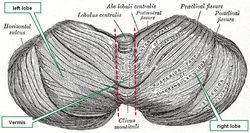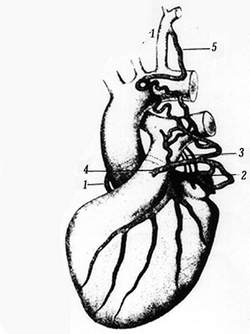
Medical Terminology Daily (MTD) is a blog sponsored by Clinical Anatomy Associates, Inc. as a service to the medical community. We post anatomical, medical or surgical terms, their meaning and usage, as well as biographical notes on anatomists, surgeons, and researchers through the ages. Be warned that some of the images used depict human anatomical specimens.
You are welcome to submit questions and suggestions using our "Contact Us" form. The information on this blog follows the terms on our "Privacy and Security Statement" and cannot be construed as medical guidance or instructions for treatment.
We have 264 guests online

Georg Eduard Von Rindfleisch
(1836 – 1908)
German pathologist and histologist of Bavarian nobility ancestry. Rindfleisch studied medicine in Würzburg, Berlin, and Heidelberg, earning his MD in 1859 with the thesis “De Vasorum Genesi” (on the generation of vessels) under the tutelage of Rudolf Virchow (1821 - 1902). He then continued as a assistant to Virchow in a newly founded institute in Berlin. He then moved to Breslau in 1861 as an assistant to Rudolf Heidenhain (1834–1897), becoming a professor of pathological anatomy. In 1865 he became full professor in Bonn and in 1874 in Würzburg, where a new pathological institute was built according to his design (completed in 1878), where he worked until his retirement in 1906.
He was the first to describe the inflammatory background of multiple sclerosis in 1863, when he noted that demyelinated lesions have in their center small vessels that are surrounded by a leukocyte inflammatory infiltrate.
After extensive investigations, he suspected an infectious origin of tuberculosis - even before Robert Koch's detection of the tuberculosis bacillus in 1892. Rindfleisch 's special achievement is the description of the morphologically conspicuous macrophages in typhoid inflammation. His distinction between myocardial infarction and myocarditis in 1890 is also of lasting importance.
Associated eponyms
"Rindfleisch's folds": Usually a single semilunar fold of the serous surface of the pericardium around the origin of the aorta. Also known as the plica semilunaris aortæ.
"Rindfleisch's cells": Historical (and obsolete) name for eosinophilic leukocytes.
Personal note: G. Rindfleisch’s book “Traité D' Histologie Pathologique” 2nd edition (1873) is now part of my library. This book was translated from German to French by Dr. Frédéric Gross (1844-1927) , Associate Professor of the Medicine Faculty in Nancy, France. The book is dedicated to Dr. Theodore Billroth (1829-1894), an important surgeon whose pioneering work on subtotal gastrectomies paved the way for today’s robotic bariatric surgery. Dr. Miranda.
Sources:
1. "Stedmans Medical Eponyms" Forbis, P.; Bartolucci, SL; 1998 Williams and Wilkins
2. "Rindfleisch, Georg Eduard von (bayerischer Adel?)" Deutsche Biographie
3. "The pathology of multiple sclerosis and its evolution" Lassmann H. (1999) Philos Trans R Soc Lond B Biol Sci. 354 (1390): 1635–40.
4. “Traité D' Histologie Pathologique” G.E.
Rindfleisch 2nd Ed (1873) Ballieres et Fils. Paris, Translated by F Gross
"Clinical Anatomy Associates, Inc., and the contributors of "Medical Terminology Daily" wish to thank all individuals who donate their bodies and tissues for the advancement of education and research”.
Click here for more information
- Details
The prefix [circum-] is Latin and means "around" or "about". It is used in medical terms such as:
- Circumcision: the root term [-cis-] meaning to "cut". To cut around
- Circumflex: the root term [flex] for [flexion] meaning to "bend". Bends around, as in "circumflex artery"
- Circumambulation: a patient that walks in circles
Also in everyday terms such as:
- Circumlocution: to talk around a subject
- Circumnavigation: To sail or navigate around
- Circumscribe: to write in circles or around a subject
- Details
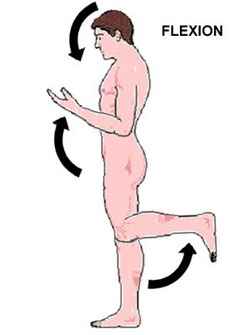
The word [flexion] comes from the Latin [flexere] meaning "to bend". In anatomy, flexion is the reduction in the angle between two bodily components that are communicated by a type of joint.
By contrast, [extension] refers to the opposite action, that is, the increase in the angle between two bodily components that are communicated by a type of joint.
The image shows flexion of the head, the upper extremity, and the lower extremity. Hover over the image to see extension of the same structures.
Excessive flexion (hyperflexion) or extension (hyperextension) of a joint can lead to potential pathology as would be the case of hyperextension of the neck as a result of a car crash (whiplash injury)
Note that in a human in the anatomical position, flexion of the upper extremity is an anterior movement, while flexion of the lower extremity is a posterior movement. You could make a case that in these image the upper extremity is performing an anteflexion (anterior flexion) while the lower extremity is performing a retroflexion (posterior flexion).
In the upper and lower extremities there are whole groups of muscles that, because of their action, are called flexors or extensors.
- Details
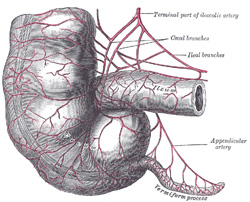
Terminal ileum, cecum,
and vermiform appendix
The word [vermis] is Latin and means "worm". The term [vermiform appendix] means "the worm-shaped appendage", and refers to a worm-like appendage that is related to the cecum, a segment of the right colon.
This structure was first described by Jacobo Berengario da Carpi in 1524, and it was Andreas Vesalius who first described it as an appendix, and suggested it looked like a worm. It has been called the [vermix] and the [cecal appendix]
The vermiform appendix* has the same four layers found in most of the abdominal digestive tract and is attached to the cecum at the point where the three tenia coli (libera, mesenterica, and omentalis) meet. The length of the vermiform appendix is variable. On average about 2.5 to 3 inches, it can be as long as 10 inches in length, with one recorded case of a 13 inch appendix!**
The location of the vermiform appendix is also subject to anatomical variation, being found in a retrocecal position in 65% of the cases. For more information on this organ's anatomical variations, click here.
The vermiform appendix is an intraperitoneal structure, as it has a peritoneal extension called the mesoappendix. Within the mesoappendix are the appendiceal arteries and veins. The appendiceal artery is usually a branch of the ileocolic artery.
Sources:
1. "The Origin of Medical Terms" Skinner, HA 1970 Hafner Publishing Co.
2. "Medical Meanings - A Glossary of Word Origins" Haubrich, WD. ACP Philadelphia
3 "Tratado de Anatomia Humana" Testut et Latarjet 8 Ed. 1931 Salvat Editores, Spain
4. "Anatomy of the Human Body" Henry Gray 1918. Philadelphia: Lea & Febiger Image modified by CAA, Inc. Original image by Henry Vandyke Carter, MD., courtesy of bartleby.com
*. It is not proper to call this structure the "appendix", as there are many appendices in the human body.
**. Personal note: The longest vermiform appendix I have personally seen was 8 inches (20.3 cm) in length, retrocolic, and the tip of the organ was actually retrohepatic!. Dr. Miranda.
- Details
This article is part of the series "A Moment in History" where we honor those who have contributed to the growth of medical knowledge in the areas of anatomy, medicine, surgery, and medical research.
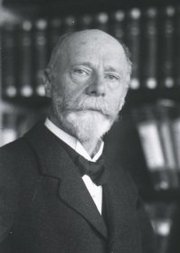
Dr. Willem Einthoven
Dr. Willem Einthoven (1860 - 1927). Einthoven was Dutch, born on 1860 in the city of Semarang in the island of Java. His father was a physician working for the Dutch military. He started his medical studies at the University of Utrecht, Holland. Having developed an interest in ophthalmology and physiology, he developed his medicine doctorate thesis on stereoscopic color vision.
In 1885 Einthoven became a Professor of Physiology at the University of Leiden. Having seen a demonstration of Augustus Waller’s “electrogram” (a device that recorded minute deviations on a mercury column when electrically stimulated) in 1887, he improved it by creating the “string galvanometer”. In 1901 Einthoven published his first recordings of what he called “elektrokardiogramm” (EKG).
The initial device was bulky, heavy, and required the patient to sit with both arms and the left leg in separate buckets of salt water, but it did record the electrical activity of the heart (Click here for an image of one of the first electrocardiographs). Eventually the device was commercialized and history was made. It was Einthoven who used the letter P,Q,R,S, and T in electrocardiography.
In 1924, Willem Einthoven was awarded the Nobel Prize in Physiology.
Sources:
1. "Willem Einthoven (1860-1927): father of electrocardiography". Merritt, C. Tan. SY. Singapore Med J 53:(1) 17
2. "Willem Einthoven (1860-1927)" Davies, M; Hollman, A. Heart. 1997 October; 78(4): 324
3. "Willem Einthoven: The development of the human electrocardiogram" Cajavilcaa, C.,Varonb, J.Resuscitation 76:3 2008; 325–328
Original image courtesy of "Images from the History of Medicine" at www.nih.gov.
- Details
The word [vermis] is Latin and means "worm".
The vermis is the name given by Galen of Pergamon (129AD - 200AD) to the median lobe of the cerebellum, since when seen from the superior aspect, this cerebellar lobe looks like a multisegmented worm. See accompanying image, or click for a larger depiction.
When seen in a median section, the cerebellar vermis looks like a multilobulated leaf with the fourth ventricle of the brain at its base. It is composed of several smaller lobules: Lingula, central, culmen, clivus, tuber vermis, pyramid, uvula, and nodular lobes.
Median section image link courtesy of UCLA Radiology
Sources:
1. "The Origin of Medical Terms" Skinner, HA 1970 Hafner Publishing Co.
2. "Medical Meanings - A Glossary of Word Origins" Haubrich, WD. ACP Philadelphia
3 "Tratado de Anatomia Humana" Testut et Latarjet 8 Ed. 1931 Salvat Editores, Spain
4. "Anatomy of the Human Body" Henry Gray 1918. Philadelphia: Lea & Febiger
Image modified by CAA, Inc. Original image courtesy of bartleby.com
- Details
"Nothing in the human body is colored, or labeled"
"The Chirurgeon must knowe the Anatomie". Thus states Thomas Vicary (1460 -1561) on the knowledge of Anatomy. He continues: "...for all authors write against those surgeons who work in a man's body not knowing the Anatomie"1. There is no doubt that knowledge must include the awareness of the possibility of anatomical variations. Some anatomical variations, like the "Corona Mortis" can be critical, and in some surgical cases, be the cause for exsanguination!
It is interesting that several medical schools are reducing the total number of hours working on, or moving away from cadaver disection in first year medical school and using computer simulations instead. No computer simulation will give the medical student the detail, variations, and feel of the tissues as actual hands-on experience. I am sure no one wants a surgeon whose first view of the internal aspect of a human body is a living patient...on the surgical table.
It is a fact that "Nothing in the human body is really colored... or labeled" or as someone else said "nothing looks exactly like the anatomy book", unless it is photography, and then each photo is taken after hours of laboring to "Netterize" the organ or area that one is trying to detail. Nothing gives the future professional the exact idea of what to expect in the future patient than the hours and hours of laborious work in the anatomy laboratory.
The same is true with anatomical variations, one "standard" digital cadaver,even with built-in anatomical variations does not give the student the sense of awe and discovery when an anatomical variation is found, interpreted, and analyzed with a group of peers, contributing to the learning process and the formation of future health care professionals.When questioning what is normal or abnormal, Dr. Elizabeth Murray says it most elegantly: "The cadaver is always right"
The image depicts a case of a coronary artery arising from the pulmonary trunk!
Sources:
1. "The Chirurgeon must knowe the Anatomie" R. Shane Tubbs Clin Anat 26:417 (2013)
2. "Two cases of an abnormal coronary artery of the heart arising from the pulmonary artery"Brooks, H; J. Anat. Physiol. 20:26-29, 1886 (anatomyatlases.org)
THIS ARTICLE IS THE THIRD IN A SERIES. TO READ THE FIRST ARTICLE CLICK HERE


